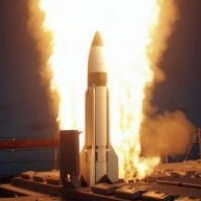Missile Defense Test Success Figures Challenged
Friday, May 21, 2010
 SM-3
SM-3
President Barack Obama has embraced flawed technology for his new missile defense plan to protect the United States from attack, say two scientific experts who reviewed testing data released by the Department of Defense.
Theodore Postol, a former Pentagon science adviser now at MIT, and George Lewis, a Cornell University physicist, took exception to claims by the Missile Defense Agency that a key component of the missile defense—the SM-3 missile—has successfully intercepted 84% of targets during tests. The scientists say the missile has really only succeeded 10-20% of the time.
A big problem with the government’s rosy assessment of the SM-3 lies in its definition of what constitutes a successful intercept. In most of the tests, the interceptor struck the incoming missile, but only diverted its warhead, not destroyed it. When it comes to stopping intercontinental ballistic missiles carrying nuclear warheads, it is critical that the interceptor blow up the warhead to keep it from striking another location.
Also, defense officials admitted that in 40% of the tests, the incoming missile contained no warhead at all.
Postol called the new missile defense system “highly fragile and brittle.” Along with Lewis, he wrote that the new plan was “nothing more than a fiction and that the policy strategy that follows from these technical myths could well lead to a foreign policy disaster.”
The controversy is reminiscent of the misleading information about the success of Patriot missiles in intercepting Saddam Hussein’s Scud missiles during the 1990-1991 Gulf War. The U.S. Army boasted that it had “intercepted” 45 of 47 Scuds. But it later turned out that the Army defined “intercepted” as including Scuds that were damaged or diverted, as well as those that landed, but did not explode.
The SM-3, like the Patriot, is manufactured by Raytheon.
-Noel Brinkerhoff
Review Cites Flaws in U.S. Antimissile Program (by William Broad and David Sanger, New York Times)
A Flawed and Dangerous U.S. Missile Defense Plan (by George N. Lewis and Theodore A. Postol, Arms Control Association)
US: Missile Blower (by Daniel Golden, Boston Globe)
- Top Stories
- Unusual News
- Where is the Money Going?
- Controversies
- U.S. and the World
- Appointments and Resignations
- Latest News
- Trump to Stop Deportations If…
- Trump Denounces World Series
- What If China Invaded the United States?
- Donald Trump Has a Mental Health Problem and It Has a Name
- Trump Goes on Renaming Frenzy






Comments